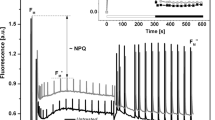Abstract
The effects of the four calcium channel blockers flunarizine, verapamil, diltiazem and nimodipine on motility and phototaxis of Chlamydomonas reinhardtio have been tested with a fully automated and computerized population system. Flunarizine inhibits motility transiently by causing the detachement of the flagella which, however, are regenerated during some hours. Phototaxis is inhibited to the same extent, but this is simply the result of the decreased motility and, hence, a non-specific effect. Verapamil causes also a detachement of the flagella with following regeneration, but in addition motility and phototaxis are inhibited by this drug to different extents, indicating the involvement of calcium channels in both processes. Diltiazem and nimodipine inhibit phototaxis without impairing motility, indicating that both processes are regulated in different ways. If diltiazem and nimodipine are applied simultaneously, no additive inhibitory effect can be observed. However, the combination of both blockers with verapamil causes and additive inhibitory effect as if verapamil is applied alone. By increasing the external calcium concentration from 10-4 M to 10-3 M the optimum of positive phototaxis is shifted to higher fluence rates. This shifting occurs also in the presence of channel blockers, but the strength of the positive reaction is influenced. These results point to the involvement of calcium channels in both phototaxis and motility, but simultaneously demonstrate the different sensitivity of the two processes to these drugs.
Similar content being viewed by others
Abbreviations
- DIL:
-
diltiazem (=benzothiazepine)
- FLU:
-
flunarizine (=(E)-1-(bis-(4-fluorophenyl(methyl)-4-(3-phenyl-2-propenyl)piperazinex2HCl)
- NIM:
-
nimodipine (=1,4-dihydropyridine)
- VER:
-
verapamil (=diphenylalkylamine) CaM, calmodulin
- PDE:
-
phosphodiesterase
- DMSO:
-
dimethylsulfoxide
References
Collis PS, Weeks DP (1978) Selective inhibition of tubulin synthesis by amiprophosmethyl during flagellar regeneration in Chlamydomonas reinhardtii. Science 202:440
Diehn B, Feinleib M, Haupt W, Hildebrand E, Lenci F, Nultsch W (1977) Terminology of behavioral responses of motile microorganisms. Photochem Photobiol 26:559–560
Enyeart JJ, Hinkle PM (1984) The calcium agonist Bay K 8644 stimulates secretion from a pituitary cell line. Biochem Biophys Res Commun 122:991–996
Gitelman SE, Witman GB (1980) Purification of calmodulin from Chlamydomonas: calmodulin occurs in cell bodies and flagella. J Cell Biol 87:764–770
Glossmann H, Ferry DR, Goll A (1984) Molecular pharmacology of the calcium channel. In: Paton W, Mitchell J, Turner P (eds) Proceedings. Iuphar 9th International Congress of Pharmacology, London, pp 1–6
Hess FD, Bayer DE (1977) Binding of the herbicide trifluralin to Chlamydomonas flagellar tubulin. J Sci Cell 24:351
Kubo K, Matsuda Y, Kase H, Yamada K (1984) Inhibition of calmodulin-dependent cyclic nucleotide phosphodiesterase by flunarizine, a calcium entry blocker. Biochem Biophys Res Commun 124:315–321
Nultsch W (1975) Phototaxis and photokinesis. In: Carlile MJ (ed) Primitive sensory and communication systems. The taxis and tropism of microorganisms and cells. Academic Press, London New York San Francisco, pp 29–90
Nultsch W (1979) Effect of external factors on phototaxis of Chlamydomonas reinhardtii. III. Cations. Arch Microbiol 123:93–99
Nultsch W (1983) The photocontrol of movement of Chlamydomonas. In: Cosens DJ, Vince-Prue D (eds) The biology of photoreception. Soc Exp Biol Symp XXXVI, pp 521–539
Nultsch W, Throm G, v. Rimscha I (1971) Phototaktische Untersuchungen an Chlamydomonas reinhardtii Dangeard in homokontinuierlicher Kultur. Arch Microbiol 80:351–369
Pfau J, Nultsch W, Rüffer U (1983) A fully automated and computerized system for simultaneous measurements of motility and phototaxis in Chlamydomonas. Arch Microbiol 135:259–264
Schmidt JA, Eckert R (1976) Calcium couples flagellar reversal to photostimulation in Chlamydomonas reinhardtii. Nature (London) 262:713–715
Senger HJ, Pfau J, Werthmüller K (1972) Continuous automatic cultivation of homocontinuous and synchronized microalgae. Methods Cell Physiol V:301–323
Stavis RL (1974) The effect of azide on phototaxis in Chlamydomonas reinhardtii. Proc Natl Acad Sci USA 71:1824–1827
Stavis RL, Hirschberg R (1973) Phototaxis in Chlamydomonas reinhardtii. J Cell Biol 59:367–377
Triggle DJ (1981) Calcium antagonists: Basic chemical and pharmacological aspects. In: Weiss GB (ed) New perspectives on calcium antagonists. Am Physiol Soc 1981, Bethesda Maryland, pp 1–18
Author information
Authors and Affiliations
Rights and permissions
About this article
Cite this article
Nultsch, W., Pfau, J. & Dolle, R. Effects of calcium channel blockers on phototaxis and motility of Chlamydomonas reinhardtii . Arch. Microbiol. 144, 393–397 (1986). https://doi.org/10.1007/BF00409890
Received:
Accepted:
Issue Date:
DOI: https://doi.org/10.1007/BF00409890




